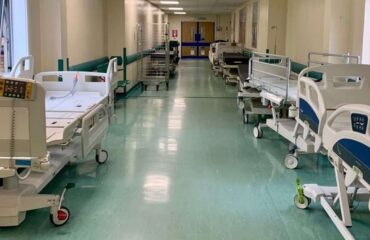A Gynecological Examination Bed is a specialized medical bed or table designed specifically for performing gynecological examinations and procedures. It provides appropriate support and positioning for the patient while offering healthcare providers access and visibility required for diagnostic or therapeutic interventions in the female pelvic region.

Key Features of a Gynecological Examination Bed
Here are the key features of a gynecological examination bed.
Adjustable Backrest and Leg Sections
- The bed is typically divided into multiple adjustable segments: headrest, backrest, seat, and leg rest.
- These sections allow for various examination and procedure positions like lithotomy, Trendelenburg, or semi-reclining.
- Adjustments can be made manually (with levers) or electronically (with remote or foot pedal controls).
Leg Supports or Stirrups
- Most gynecological beds include adjustable leg holders or stirrups to secure and position the patient’s legs.
- These are designed to help maintain the lithotomy position, which is critical for most gynecological exams.
- They are padded for patient comfort and are easily sanitized.
Height Adjustment Mechanism
- The examination bed often includes a manual crank or electric motor to raise or lower the entire table.
- This feature helps accommodate the healthcare provider’s ergonomic needs and ensures easy patient transfer from a wheelchair or stretcher.
Padded and Antimicrobial Upholstery
- The surface is cushioned with high-density foam for patient comfort during potentially lengthy procedures.
- Upholstery materials are waterproof, antimicrobial, and easy to disinfect, which supports infection control protocols.
Instrument Tray and Utility Attachments
- Many beds come with removable stainless steel trays or drawers to hold medical instruments and disposables.
- Some models feature integrated holders for examination lights, sanitary napkin attachments, and waste containers.
Electrical Controls (in Advanced Models)
- High-end models feature electronic adjustment for backrest, height, leg section, and even tilt.
- Some come with programmable positions to speed up patient setup for repeat procedures.
Safety Features
- Side railings or straps may be available to ensure patient safety during movement or anesthesia.
- Some beds have emergency stop switches on powered units for added safety.
Mobility and Locking Mechanism
- Equipped with wheels and locking brakes to facilitate mobility within the clinic and ensure stability during use.
Common Uses of Gynecological Examination Bed
Here are the common uses of a gynecological examination bed.
Routine Gynecological Examinations
- The bed is primarily used for standard pelvic exams, allowing doctors to inspect the vaginal canal, cervix, uterus, and ovaries.
- Provides the correct positioning (typically lithotomy) for both visual and tactile assessment using speculums and gloved hands.
Pap Smear and Cervical Screening
- Used during Papanicolaou (Pap) smear tests to collect cervical cell samples.
- The adjustable leg rests help stabilize the patient in an optimal posture for cervical access and visualization using a speculum.
Intrauterine Device (IUD) Insertion/Removal
- Essential for insertion or removal of contraceptive devices such as copper T or hormonal IUDs.
- The structure supports safe and sterile handling of instruments and comfortable patient positioning during the process.
Colposcopy Procedures
- A colposcopy (examination of the cervix using a magnifying device) requires stable patient positioning and unobstructed access.
- The bed helps the gynecologist maintain a clear view while facilitating biopsy or sample collection if abnormal cells are found.
Fertility Assessments and Procedures
- Used during transvaginal ultrasounds, hysterosalpingography (HSG), or intrauterine insemination (IUI) to evaluate fertility.
- The bed allows for precise positioning and tool accessibility for delicate reproductive procedures.
Minor Surgical Interventions
- Gynecological beds are often used in outpatient or minor procedure settings for:
- Cervical polyp removal
- Endometrial biopsy
- Bartholin cyst drainage
- Cervical cauterization
- The sturdy and adjustable design ensures safe positioning during local anesthesia-based treatments.
Prenatal and Postnatal Check-ups
- During pregnancy, especially in early stages, the bed allows for pelvic examination and early anomaly screening.
- In postpartum check-ups, it helps assess healing and check for any complications related to delivery.
Vaginal Swabs and STD Testing
- Proper access and positioning are necessary for taking vaginal, cervical, or urethral swabs for testing sexually transmitted infections.
- Ensures patient safety and clinician efficiency in a hygienic setup.
Ultrasound-Guided Procedures
- Commonly used alongside transvaginal ultrasound equipment for diagnostic imaging, including:
- Follicular tracking
- Endometrial thickness measurement
- Ovarian cyst assessment
Benefits of Gynecological Examination Bed
Here are the detailed benefits of a gynecological examination bed for both patients and healthcare providers:
Optimal Patient Positioning
- The bed’s design allows patients to be positioned comfortably and correctly, especially in the lithotomy position, which is essential for most gynecological exams and procedures.
- Proper positioning ensures full visibility and access to the pelvic area, improving examination accuracy.
Enhanced Patient Comfort
- Features like padded surfaces, adjustable backrests, and ergonomic stirrups reduce discomfort during potentially sensitive procedures.
- Reclining and adjustable sections help accommodate different body types and health conditions (e.g., pregnancy, obesity, or limited mobility).
Improved Clinical Efficiency
- Quick and easy adjustments (manual or electric) save time for clinicians, allowing for faster patient turnover.
- Accessory trays, drawers, and attachment holders help in organizing instruments and disposables, making procedures more streamlined.
Greater Safety and Hygiene
- Upholstery is typically made from antimicrobial and easy-to-clean materials, which supports infection control.
- Advanced models include safety rails, emergency stop switches, and sturdy construction to ensure patient safety during procedures.
Multifunctional Use
- These beds are suitable for a wide range of applications—from routine exams to minor surgical procedures, making them highly versatile in OB-GYN clinics, fertility centers, and hospitals.
- Can also support ultrasound-guided procedures, colposcopy, and IUD insertion/removal.
Accessibility for Differently-Abled Patients
- Beds with height adjustment and motorized movement facilitate easier patient access—especially for individuals using wheelchairs or those with limited mobility.
- This increases inclusivity and reduces physical strain during transfers.
Professional Appearance and Patient Trust
- A well-designed, modern examination bed gives the clinical environment a more professional, clean, and organized look.
- This can help improve patient confidence and reduce anxiety, especially during intimate or first-time gynecological exams.
Customizable Features for Clinical Needs
- High-end beds offer programmable positions, additional attachments (like light holders, IV poles, or waste bins), and remote-control operation, allowing customization based on the clinic’s workflow.
These advantages make gynecological examination beds an essential investment for facilities aiming to offer high-quality women’s health care.


